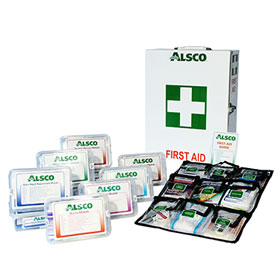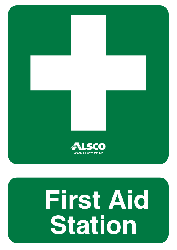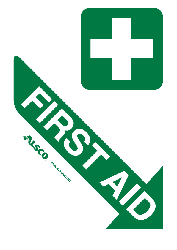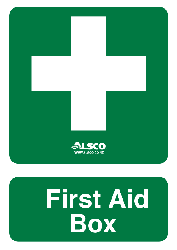A well-stocked first-aid kit is a necessity in the workplace as it will enable you to handle an emergency.
There are first aid kits available for homes, businesses, vehicles as well as portable kits that you can take with you wherever you go.
According to the Health and Safety at Work Act 2015, companies must provide protective gear in the workplace and rescue equipment for all its employees.
The other important provision is first aid facilities with a trained First Aid officer to manage and use in case of an emergency.
You must have at least one kit and first aid officer for every 50 employees on board. This will ensure that staff members are well taken care of during an injury or accident.
You can purchase or rent First Aid kits which are sturdy, easy to carry, and easy to use. You can opt for Managed First Aid kits which are easy to use, easy to maintain and replace when necessary.
What Should a First-Aid Kit Include?

Alsco’s Managed Rental Program for First Aid Kit Supplies
These are some of the items you can have in a First Aid Kit:
- an up-to-date first-aid manual
- a list of emergency phone numbers
- antiseptic wipes
- antibiotic ointment
- saline solution (like hydrogen peroxide)
- extra prescription medicines (perfect for staff on the road while on duty)
- Eye pads and sterile gauze pads of different sizes
- adhesive tape and adhesive bandages (Band-Aids) in several sizes
- a splint
- Tweezers, sharp scissors and safety pins
- disposable instant cold packs
- plastic non-latex gloves (at least 2 pairs)
- mouthpiece for giving CPR (available from reputable health organizations)
- A Defibrillator (AED)
How to Get The Most From Your First Aid Kits
- Read the first-aid manual to better understand the First Aid kit contents. These manuals must be checked regularly to check if they are up to date.
- When installing First Aid kits in the workplace, they must be easily accessed and well labelled. You can get clear signage that will direct First Aid officers and other staff members in the event of an emergency.
- Regular kit checks are important. Replace missing items or anything that has expired. Items such as gauze, gloves, solutions and bandages will lose their sterility over time and these must be replaced.
- Have regular training for First Aid officers and the staff on First Aid kits, procedures and emergency protocols. Remind staff members that even when the first aid kits are used for an emergency, they MUST call emergency services in case of a serious injury.
[b3_row]
[b3_column lg=”3″ md=”12″ sm=”12″ xs=”12″ ]
[/b3_column]
[b3_column lg=”3″ md=”12″ sm=”12″ xs=”12″ ]
[/b3_column]
[b3_column lg=”3″ md=”12″ sm=”12″ xs=”12″ ]
[/b3_column]
[b3_column lg=”3″ md=”12″ sm=”12″ xs=”12″ ]
[/b3_column]
[/b3_row]
Why is First Aid Important in The Workplace?
- It is the first course of action in an emergency before calling emergency services. If a staff member is injured, say in the eye by corrosive substances, you must quickly wash out the eye. In the case of a cut, pressure must be applied to stop the bleeding. More serious cases like cardiac arrest must be controlled using an AED within the first 5 minutes of the emergency.
- It saves time and money. Having well-stocked First Aid kits in the workplace will prevent staff members from missing work or staying away for days from duty. It also helps to boost morale in the workplace because First Aid kits show that their wellbeing is being considered.
- It will prevent an injury from becoming worse. During any emergency, time is of the essence. Waiting for an ambulance or ignoring an injury can lead to an escalation of the situation. It can lead to a bigger health threat or can even prove fatal in some cases.
- When staff members are regularly trained and able to administer first aid, they have already learned an extra life skill. With the help of the resident first aid officer, a staff member can take care of an injury in no time and report back to work.
How Do You Choose the Best First Aid Kits?
- First Aid kits must be suitable for the environment it will be used in. When choosing workplace kits, you should keep in mind the following factors:
- The workplace size and layout
- Number of staff members
- Workplace hazards
- Is the workplace in a remote place
- How far the workplace is from an emergency room.
- Workplace First Aid Kits must be well-stocked and easily accessible. Aside from the regular bandages, saline solution, gauze and medicines, a workplace kit should have a defibrillator which are lifesaving in the event of a cardiac arrest. Some workplaces may have first aid rooms that contain more equipment and sufficient resting space for ailing staff.
Company vehicles must also have first aid kits for the drivers and their passengers. They will usually be smaller and easy to store or carry and come in more sturdy storage to prevent any damages. - First aid kits must be clearly labelled with the white cross against a green background. One of the main things that emergency drills teach in the workplace includes being able to find first aid kits and AEDs within the building in case of an emergency.
- When buying or renting the best First Aid kits, you must make sure that they are legally compliant. This means that is should follow workplace First Aid code by ensuring that all staff are aware of their location. A first aid officer should be present to assist in case of an emergency and it must be well-stocked as required.
Turn to Alsco New Zealand for Managed Rental First Aid Kits at a minimal fee. We offer both vehicle and workplace kits that are compliant and well equipped. Alsco NZ will install them, conduct regular checks and restock them without additional charge.





